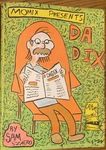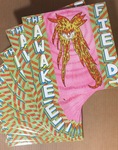
edited by Monte Beauchamp
comics by Drew Friedman, Dan Zettwoch, Mark Alan Stamaty, et al
It's hard to gauge what's in store when you first espy a copy of Masterful Marks, so we're going to let you know that, while in the world of comics you often can judge a book by it's cover, this is one of those books that fits the old adage, as between its staid and stolid coversis a riot of colorful comics homages to the giants of comics, by a great assemblage of currently working cartoonists. Among the pieces you will find here are Mark Alan Stamaty on Jack Kirby, Beauchamp and Ryan Heshka on Jerry Siegal and Joe Shuster, Dan Zettwoch on Tezuka Osamu, Denis Kitchen on Dr. Seuss (and yes, for those of you who don't know, he started out doing comics), Peter Kuper on Harvey Kurtzman, and Drew Friedman turns in what may be the best comics work of his career with "R. Crumb & Me." And there's plenty more. While we would take issue with Beauchamp's decision to include comics-packagers/promoters like Walt Disney and Hugh Hefner in the collection, presumably for commercial reasons, given their greater name recognition with the general public, we're not going to let it detract from our enjoyment of the bulk of the book. So, make sure to pry open this one when you see it, and take a look.

It's been almost 40 years, but worth the wait. Mark Alan Stamaty's legendary, Village Voice strip, MacDoodle St. is back! The looooong out of print (paperback only) collection has now been reissued by New York Review Comics in a spiffy hardcover edition that includes seven installations of the precursor strip, "Garble Dee Goo" along with an all new, 18 page addendum, to boot!
Mark Alan Stamaty's comics evince a distractibility that borders on anarchy and leads to mayhem and even chaos, yes, but attention deficit, no! Stamaty focuses on the details at the same time as his mind wanders all over creation (well, all over New York City) producing some completely original, highly engaging and hugely entertaining comics in the process. Fans of Ben Katchor might find themselves feeling a familiar something now and again as they make their way through MacDoodle St. as that approach to the quotidian that is permeated by an effervescent, off-kilter and unpindownable sensation is present here as well, albeit in a much more frenetic form.
Don't miss this gem.
We posted a quickie preview on Instagram, HERE.

Before, Washingtoons, before MacDoodle Street, before even Who Needs Donuts?, there was... Yellow Yellow, the book where Mark Alan Stamaty first unleashed his pyrotechnically prodigious penmanship on the world. The pages of this simple children's story overflow with hyperactively imaginative renderings of the urban (read NYC) environment, launching a way of seeing that has influenced a slew of subsequent works, perhaps most notably (most egregiusly cashing in on another's [in]sight?), Where's Waldo.
Now, after being out of print for well over 40 years, it has been brought back into print in a sturdy hardcover edition by Drawn & Quarterly's Enfant imprint.

Stamaty’s cult masterpiece is now back in print after a thirty year hiatus, in a beautifully produced hardcover edition. Once you start looking at this book, it's really hard to stop. You just get sucked in. The appeal of this book lies in the neural connections between the eyes and the brain and the hand that draws, it’s pretty hard to explain... but those who are already familiar with Stamaty’s work from his many-year run on Washingtoons in the Village Voice, and, more recently, his endpage strip in the New York Times Book Review, Boox, will know what we’re talking about. This is technically a kids’ book -- and kids will dig it, especially those hyper-brainy types (this is the perfect book to save them from a life of video-game addiction before it’s too late), and was more than likely an inspiration to Martin Handford, the creator of the Where’s Waldo series as well as the team responsilbe for the I Spy book series -- but it will, perhaps, be most appreciated by obsessive-compulsive adults -- you can be sure that Ben Katchor has this book in his personal library. The level of detail in the drawings that fill this book has to be seen to be believed. Furthermore, it is not just detail, but detail with an agenda, and that agenda can perhaps best be summed up in the phrase, "reality is what you make it." Reality as Stamaty makes it, is, more than likely, not reality as seen by you or I, but Who Needs Donuts makes us realize that it doesn't have to be that way, that the possibilities are only limited by our imaginations. We really recommend this one!










